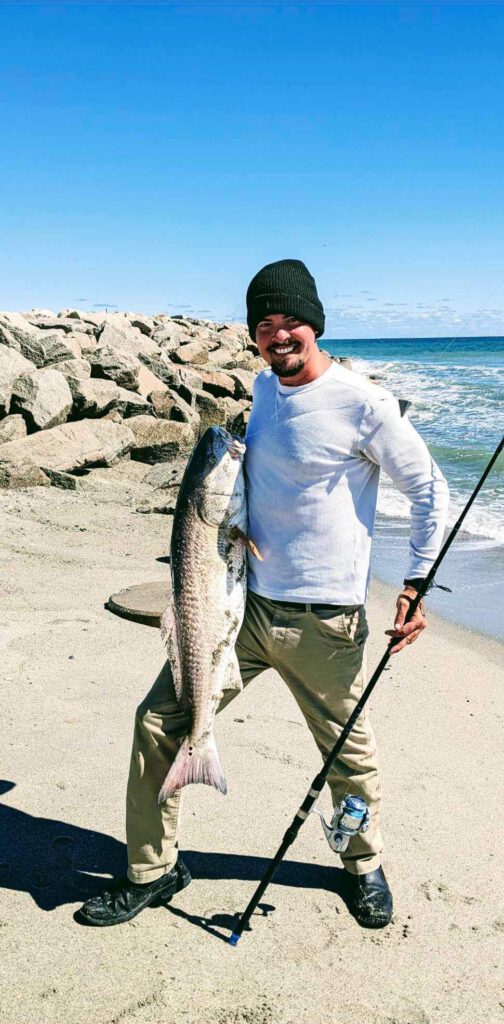Carolina Beach – April 2024
Lewis, of Island Tackle and Hardware, reports that whiting have been showing up in the Cape Fear River, mostly down south and closer to the mouth.
Anglers casting shrimp along shoreline banks, docks, or oysters are catching both red drum and black drum.
Surf anglers have been finding pufferfish, whiting, stingrays, and some bluefish that are starting to arrive.
Black drum are being caught by those fishing down around the rocks at Fort Fisher.
Nearshore anglers look forward to Atlantic bonito starting to show up over the shallower structures any day now. These nearshore wrecks are currently seeing a decent sheepshead bite (before these fish migrate back inshore).
Further off the beach, bottom fishing is producing nice-sized black sea bass and amberjacks.
Gulf Stream runs, when they can happen, are generating wahoo and blackfin tuna, with the lucky chance of yellowfins (if they show up over the coming weeks).
Christian, of Seahawk Inshore Fishing Charters, reports that targeting redfish during periods of lower tides has been best, not only to congregate the fish but also to have the water slightly warmer. A bunch of smaller red drum are starting to push around on the banks and near oyster structure. Both bottom-rigged shrimp and lightly weighted soft plastics are having success.
Anglers fishing with shrimp are also landing a few black drum when targeting areas of oysters. Moving into April, the area usually sees a bigger push of black drum into the river.
Mason, of Grand Slam Fishing Charters, reports that recent trips have been focusing on red drum action in the Cape Fear River. The best successes have been more upriver and targeting the high to falling tides on banks with 4-7’ depths. These fish are mostly striking at Carolina-rigged live or dead shrimp. If set up with only artificials, a Vudu or Gulp shrimp will also entice strikes.
Black drum are around and starting to pick up as warming water temperatures get them moving. April usually sees a nice push of fish into the river to stage around structure.
Speckled trout action has been getting better now that shrimp are showing up. Floating a live shrimp around holes and points off the spoil islands is a great tactic. If down closer to the inlet in the lower river, fish these live shrimp around oyster banks that have some current.
Tommy, of Mungo Fishing Charters, reports that red drum are starting to spread out a bit more as they transition out of their winter patterns. With the consistent spring winds, it’s still a good idea to focus efforts in more protected areas in the backs of creeks or in the marsh. Look for these fish to be breaking up into smaller groups and staging around oyster bars or holes in the coming weeks. Bottom fishing with shrimp still works great, or anglers with soft plastics are doing well with lightly weighted jig heads.
Black drum are being caught on the same bottom rigs with shrimp. These fish are more structure oriented, so targeting areas near oysters, docks, or other hard structure is key.
Speckled trout action hasn’t quite kicked off, but they’re occasionally mixed in the action. Most of the time these fish are being found in holes throughout the creeks, especially those with some current. This could change quickly, though, if we see a stretch of warm weather that pushes them out towards the creek mouths and into the ICW.
Rod, of OnMyWay Fishing Charters, reports that Atlantic bonito have just started to show up, and as soon as the winds allow, anglers should begin seeing them in good numbers. These first waves of fish tend to stay below the surface, requiring anglers to target structure and areas of bait. Trolling is great for scouting the bite, with a #1 planer dragging a #0 or #00 Clarkspoon being the top choice.
A favorite setup is using spoons that have two-toned color patterns and are fished on 25’ leader lines. Some anglers also have success with Yo-Zuri deep diver plugs.
Black sea bass action has been phenomenal in the 15-25 mile range. Anglers on recent trips are able to fill quick limits of the 16-20” fish, especially with how ravenous these fish feed. Anglers should keep an eye out for lower relief areas (such as ledges), and it’s best to hold back fishing efforts until finding structure holding bait.
When running out deeper (35-50 miles), anglers are also catching big vermilion snapper and triggerfish.
Bottom fishing is producing a bunch of throwback grouper and American red snapper. Anglers need to be ready to safely release these fish with proper, required descending devices.
King mackerel and false albacore are still well offshore, as they’re holding in the 68-degree water. Any anglers that fish offshore should have a recent SST shot to know in what areas to start efforts. Right now, this edge is out around 42-50 miles.
Gulf Stream runs have been producing wahoo over the deeper structure. Be looking for areas in the 220’ area with 70-72 degree surface temperatures.
Blackfin tuna are mixed in, though most are out even deeper and holding on rocks and structure. Any spring offshore trolling spreads should include a 4” cedar plug just for this reason. The top color patterns are blue/white or natural (brown).
Anthony, of Kure Beach Pier, reports that pier anglers are anticipating seeing catches of whiting, black drum, pufferfish, and the occasional speckled trout.
Water temperatures are still on the cooler side, so bottom fishing will likely produce most of the action over the coming weeks.


